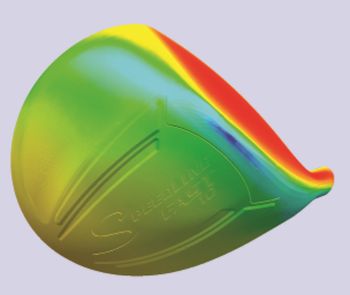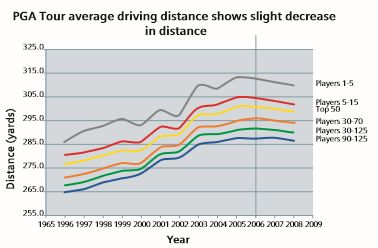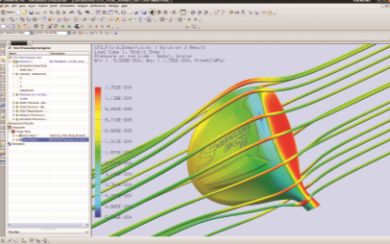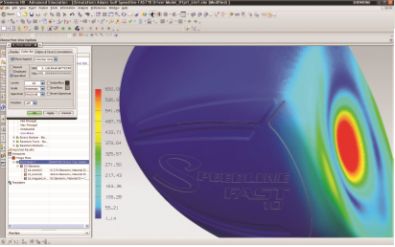 |
| September 10, 2013 | Volume 09 Issue 34 |
Designfax weekly eMagazine
Archives
Partners
Manufacturing Center
Product Spotlight
Modern Applications News
Metalworking Ideas For
Today's Job Shops
Tooling and Production
Strategies for large
metalworking plants
Is bigger better? Not always when it comes to golf driver heads

"We can basically use one 3D model," says Jeff Albertsen, design engineer, Adams Golf. "Just click a button on the NX screen, and we're in stress and strain analysis. Click another button, and we're in a deflection analysis. Click another button and we're running flow sims. Integrating all those analysis tools into our 3D modeling software has benefited us greatly."
Adams Golf designs, assembles, markets, and distributes premium-quality, technologically innovative golf clubs. All of the equipment at Adams Golf is designed and tested using a variety of sophisticated, state-of-the-art tools, such as 3D CAD and rendering, CAE, advanced mass property analysis, and equipment durability testing. And it's this high-quality craftsmanship and cutting-edge engineering that have made Adams Golf a true leader and innovator in the golf business.
The golf club industry is highly competitive and has undergone significant transformation since the 1990s, with companies that have invested heavily in R&D seeing greater success in the marketplace. In order to compete effectively against companies with larger marketing budgets, Adams Golf believes that it must focus on using technology to innovate and to bring new products to market faster than the competition.
Recent trends in driver design
"I don't care if you're a tour player, I don't care if you're the weekend warrior or a beginner," says Tim Reed, vice president of research and development, Adams Golf. "The first thing you want is distance." In an effort to increase distance and make the club more forgiving, golf club manufacturers have progressively increased driver head size over the years.
Scott Burnett, director of advanced product development, points out, "They've gone from 250 cc maybe 10 years ago, to 460 cc, which is now the maximum allowed by the rules of golf. Additionally, the driver club head designs have become 'extreme-dimension' in shape to chase the USGA maximum moment of inertia [MOI] limit." In recent years, however, it was noted that tour professionals were actually losing distance.

Trends in PGA Tour driving distances.
Data-driven insight leads to breakthrough innovation
Jeff Albertsen, design engineer, Adams Golf, recalls, "We've seen driving distances actually decrease over the last couple years. I think the trigger was driving distance on the PGA Tour, because those are obviously the best players in the world. We decided to test: Why is this happening? Why are these distances decreasing?"
Through player testing, aerodynamic wind tunnel testing, and computational fluid dynamics (CFD), Adams Golf identified that large MOI club heads (at or near 460 cc) are subject to aerodynamic forces large enough to impact club-head speed. More specifically, Adams Golf found that the reduction in club-head speed measured during player tests correlates strongly with the resulting increase in aerodynamic drag for extreme-dimension club heads. Adams Golf applied this knowledge to product development, resulting in the notable 2009 release of its Speedline driver -- a large-dimension and high-inertia driver with low aerodynamic drag. The Speedline driver displays aerodynamic characteristics similar to smaller club heads. That means reduced drag forces, enabling increased club-head speeds and greater distance for all golfers. Since its launch, the Speedline driver has been involved in several tour victories. Golf Digest named the Speedline driver its 2009 Gold Winner, stating, "There is a sense that Adams has discovered something others have overlooked."

Visualization of streamlines and club-face pressure distribution using NX Flow.
Focus on simulation technology
"We have to add new technology and new aspects to the product in almost every product we launch," says Burnett. Having already developed the industry's first driver to be engineered using wind tunnel technology for superior aerodynamics, Adams Golf wanted to follow with a product that was even better. One of the features of the original Speedline driver was the smaller face area, which helped reduce aerodynamic drag. For the next-generation Speedline driver, Adams Golf wanted to increase the face area to improve impact efficiency while delivering even higher club speeds -- a very challenging proposition.
Relying purely on experimental methods such as wind tunnel testing or player club-head speed testing is costly and time consuming. To achieve the optimal solution that satisfies these competing objectives in a timely manner, Adams Golf decided to use NX Flow software from Siemens PLM Software in its process for designing driver heads. "We were already using the (NX) design software, so it fit very well," says Burnett. In fact, Adams Golf considers the application and management of its technological resources, including NX product development software, as critical to its innovation and success. "We've used NX Flow to develop the last couple of products. It's pretty much an integral part of the design process for driver heads now," Burnett says.
NX and the evolution of the Speedline driver
"The story of the Speedline driver is a good example of implementing NX in a process," says Burnett. "The first Speedline driver was really designed or developed using what I would call the old process. We made a prototype. We made a lot of guesses about aerodynamics. And we made a lot of tradeoffs. So what NX enabled us to do in the next generation of driver is to get that face size back up. And we were able to do that by expanding the face up and then doing a lot of iterations within CFD, within NX Flow, to get the drag back down to where that original Speedline driver had been."
"We were able to make subtle modifications to the face area and the transition areas from the face to the body of the club to help keep that airflow attached and reduce drag even more," Albertsen explains. "Using NX Flow software, we were able to run simulations on several different iterations of the design and ultimately find the final design, which was the lowest drag."

"We've used NX Flow to develop the last couple of products. It's pretty much an integral part of the design process for driver heads now," says Scott Burnett, director of product development, Adams Golf.
Another advantage of using the NX Flow software was that engineers could very easily simulate the different orientations seen by the club head as it moves through the swing. For the newest Speedline Fast 10 driver, Adams Golf engineers were able to ensure that the flow does not separate during the early stages of the swing, resulting in lower drag in all orientations, and thereby improving on an already superior design. After the design was completed, wind tunnel tests and player tests were conducted to further validate the final design. "Once we produce the prototype, we take it down to the wind tunnel and we're able to get the real data," says Reed. "What's great to find is the actual software and the results of the wind tunnel are almost identical."
Player tests have also validated the CFD-based design approach, with each successive generation of the Speedline driver achieving higher club-head speeds than the previous generation.
Faster iterations with an integrated design and simulation environment
Having an integrated simulation toolset has helped Adams Golf achieve shorter product development cycles. Since the company uses NX for design and rendering, Adams Golf engineers are able to leverage the same models for simulation.
"Once we create the model, we can go down multiple paths concurrently where we can prove out the colors, and the marketing side of it, and the graphic side of it, all parallel to the actual performance of the product," says Reed. "As one change is made, another change can be made -- and it's all concurrent."
According to Reed, a key part of realizing these and other benefits is system ease/friendliness. "The CAD designers and engineers came to me noting how easy NX is to use and how fast it is to use, so we have more iterations going on now to guarantee that we're going to have that world-class product," Reed says.
Scott Burnett is convinced that the incremental improvements made since the first Speedline driver would not have been possible by physically experimenting -- there simply would not have been enough time for all the iterations. The integrated NX Advanced Simulation environment with the embedded NX Nastran solver is used for a variety of applications, including static stress-strain analysis and dynamic analysis, such as simulating club-ball impact. "We can test fatigue. We can test durability. We can test how the club's going to react during the swing," says Albertsen.
"And then we do the aerodynamic simulations with CFD," adds Burnett. "That's helped us a lot in trying to compress our product life cycles."
"We can take our 3D model, just click a button on the NX screen, and we're in stress and strain analysis," Albertsen explains. "Click another button, and we're in a deflection analysis. Click another button and we're running flow simulations. So being able to integrate all those different analysis tools right into our 3D modeling software has benefited us greatly as well."
The ultimate role of NX: Speed to market
In the competitive environment faced by Adams Golf, bringing new innovations to market sooner can make all the difference. By using NX, Adams Golf has been able to shorten its product development cycle significantly.
"The typical manufacturing process for us -- from conception to seeing actual prototype parts -- is anywhere from 30 to 60 days," says Albertsen. "Now using the NX Flow software, we can design, test the design, validate that it's going to work, and actually have a real-time working concept in probably less than 20 days. So by using the NX software, we can cut down on manufacturing lead times, we can cut down on manufacturing costs, and we can cut down on testing times."
"The role NX ultimately plays is speed to market," says Reed, "providing us extraordinary flexibility and adaptability to the ever-changing environment of the golf industry."
Want more information? Click below.
NX software -- Siemens PLM Software
Source: Siemens
Published September 2013
Rate this article
View our terms of use and privacy policy
